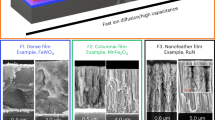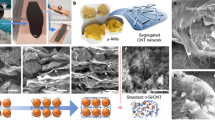Abstract
Safe and powerful energy storage devices are becoming increasingly important. Charging times of seconds to minutes, with power densities exceeding those of batteries, can in principle be provided by electrochemical capacitors—in particular, pseudocapacitors1,2. Recent research has focused mainly on improving the gravimetric performance of the electrodes of such systems, but for portable electronics and vehicles volume is at a premium3. The best volumetric capacitances of carbon-based electrodes are around 300 farads per cubic centimetre4,5; hydrated ruthenium oxide can reach capacitances of 1,000 to 1,500 farads per cubic centimetre with great cyclability, but only in thin films6. Recently, electrodes made of two-dimensional titanium carbide (Ti3C2, a member of the ‘MXene’ family), produced by etching aluminium from titanium aluminium carbide (Ti3AlC2, a ‘MAX’ phase) in concentrated hydrofluoric acid, have been shown to have volumetric capacitances of over 300 farads per cubic centimetre7,8. Here we report a method of producing this material using a solution of lithium fluoride and hydrochloric acid. The resulting hydrophilic material swells in volume when hydrated, and can be shaped like clay and dried into a highly conductive solid or rolled into films tens of micrometres thick. Additive-free films of this titanium carbide ‘clay’ have volumetric capacitances of up to 900 farads per cubic centimetre, with excellent cyclability and rate performances. This capacitance is almost twice that of our previous report8, and our synthetic method also offers a much faster route to film production as well as the avoidance of handling hazardous concentrated hydrofluoric acid.
This is a preview of subscription content, access via your institution
Access options
Subscribe to this journal
Receive 51 print issues and online access
$199.00 per year
only $3.90 per issue
Buy this article
- Purchase on Springer Link
- Instant access to full article PDF
Prices may be subject to local taxes which are calculated during checkout



Similar content being viewed by others
References
Simon, P. & Gogotsi, Y. Materials for electrochemical capacitors. Nature Mater. 7, 845–854 (2008)
Augustyn, V. et al. High-rate electrochemical energy storage through Li+ intercalation pseudocapacitance. Nature Mater. 12, 518–522 (2013)
Gogotsi, Y. & Simon, P. True performance metrics in electrochemical energy storage. Science 334, 917–918 (2011)
Murali, S. et al. Volumetric capacitance of compressed activated microwave-expanded graphite oxide (a-MEGO) electrodes. Nano Energy 2, 764–768 (2013)
Yang, X., Cheng, C., Wang, Y., Qiu, L. & Li, D. Liquid-mediated dense integration of graphene materials for compact capacitive energy storage. Science 341, 534–537 (2013)
Zheng, J. P., Cygan, P. J. & Jow, T. R. Hydrous ruthenium oxide as an electrode material for electrochemical capacitors. J. Electrochem. Soc. 142, 2699–2703 (1995)
Naguib, M. et al. Two-dimensional nanocrystals produced by exfoliation of Ti3AlC2 . Adv. Mater. 23, 4248–4253 (2011)
Lukatskaya, M. R. et al. Cation intercalation and high volumetric capacitance of two-dimensional titanium carbide. Science 341, 1502–1505 (2013)
Nicolosi, V., Chhowalla, M., Kanatzidis, M. G., Strano, M. S. & Coleman, J. N. Liquid exfoliation of layered materials. Science 340, 6139 (2013)
Ghaffari, M. et al. High-volumetric performance aligned nano-porous microwave exfoliated graphite oxide-based electrochemical capacitors. Adv. Mater. 25, 4879–4885 (2013)
Tao, Y. et al. Towards ultrahigh volumetric capacitance: graphene derived highly dense but porous carbons for supercapacitors. Sci. Rep. 3, 2975 (2013)
Jung, I., Dikin, D. A., Piner, R. D. & Ruoff, R. S. Tunable electrical conductivity of individual graphene oxide sheets reduced at “low” temperatures. Nano Lett. 8, 4283–4287 (2008)
Barsoum, M. W. MAX Phases: Properties of Machinable Ternary Carbides and Nitrides (John Wiley & Sons, 2013)
Naguib, M., Mochalin, V. N., Barsoum, M. W. & Gogotsi, Y. MXenes: a new family of two-dimensional materials. Adv. Mater. 26, 982 (2014)
Xie, X. et al. Surface Al leached Ti3AlC2 substituting carbon for catalyst support served in a harsh corrosive electrochemical system. Nanoscale 6, 11035–11040 (2014)
Peng, Q. et al. Unique lead adsorption behavior of activated hydroxyl group in two-dimensional titanium carbide. J. Am. Chem. Soc. 136, 4113–4116 (2014)
Tang, Q., Zhou, Z. & Shen, P. Are MXenes promising anode materials for Li ion batteries? computational studies on electronic properties and Li storage capability of Ti3C2 and Ti3C2X2 (X = F, OH) monolayer. J. Am. Chem. Soc. 134, 16909–16916 (2012)
Mashtalir, O. et al. Intercalation and delamination of layered carbides and carbonitrides. Nature Commun. 4, 1716 (2013)
Halim, J. et al. Transparent conductive two-dimensional titanium carbide epitaxial thin films. Chem. Mater. 26, 2374–2381 (2014)
Chang, F., Li, C., Yang, J., Tang, H. & Xue, M. Synthesis of a new graphene-like transition metal carbide by de-intercalating Ti3AlC2 . Mater. Lett. 109, 295–298 (2013)
Enyashin, A. N. & Ivanovskii, A. L. Two-dimensional titanium carbonitrides and their hydroxylated derivatives: structural, electronic properties and stability of MXenes Ti3C2−xNx(OH)2 from DFTB calculations. J. Solid State Chem. 207, 42–48 (2013)
Madsen, F. T. & Müller-Vonmoos, M. The swelling behaviour of clays. Appl. Clay Sci. 4, 143–156 (1989)
Hensen, E. J. & Smit, B. Why clays swell. J. Phys. Chem. B 106, 12664–12667 (2002)
Lis, D., Backus, E. H. G., Hunger, J., Parekh, S. H. & Bonn, M. Liquid flow along a solid surface reversibly alters interfacial chemistry. Science 344, 1138–1142 (2014)
Mashtalir, O., Naguib, M., Dyatkin, B., Gogotsi, Y. & Barsoum, M. W. Kinetics of aluminum extraction from Ti3AlC2 in hydrofluoric acid. Mater. Chem. Phys. 139, 147–152 (2013)
Conway, B. Electrochemical capacitors based on pseudocapacitance. In Electrochemical Supercapacitors: Scientific Fundamentals and Technological Applications (Kluwer Academic/Plenum, 1999)
Dmowski, W., Egami, T., Swider-Lyons, K. E., Love, C. T. & Rolison, D. R. Local atomic structure and conduction mechanism of nanocrystalline hydrous RuO2 from X-ray scattering. J. Phys. Chem. B 106, 12677–12683 (2002)
Wang, J., Polleux, J., Lim, J. & Dunn, B. Pseudocapacitive contributions to electrochemical energy storage in TiO2 (anatase) nanoparticles. J. Phys. Chem. C 111, 14925–14931 (2007)
Levi, M. D. et al. Solving the capacitive paradox of 2D MXene by electrochemical quartz-crystal admittance and in situ electronic conductance measurements. Adv. Energy Mater. http://dx.doi.org/10.1002/aenm.201400815 (2014)
Simon, P., Gogotsi, Y. & Dunn, B. Where do batteries end and supercapacitors begin? Science 343, 1210–1211 (2014)
Acknowledgements
We thank O. Mashtalir and Z. Ling for help with material characterization. This work was supported by the US National Science Foundation under grant number DMR-1310245. Electrochemical research was supported by the Fluid Interface Reactions, Structures and Transport (FIRST) Center, an Energy Frontier Research Center funded by the US Department of Energy, Office of Science, and Office of Basic Energy Sciences. XRD, X-ray photoelectron spectroscopy, SEM and TEM investigations were performed at the Centralized Research Facilities at Drexel University.
Author information
Authors and Affiliations
Contributions
M.G. conducted material synthesis and XRD analysis. M.R.L. performed electrochemical measurements and SEM analysis. M.-Q.Z. performed TEM analysis. M.W.B. and Y.G. planned and supervised the research. M.R.L., M.G., M.W.B. and Y.G. wrote the manuscript.
Corresponding authors
Ethics declarations
Competing interests
The authors declare no competing financial interests.
Extended data figures and tables
Extended Data Figure 1 Processing of MXene clay.
a, Dried and crushed powder. b, c, Hydrated clay is plastic and can be readily formed and moulded. d, Demonstration of films produced in the roller mill. e, f, Rolled freestanding film being lifted off Celgard membranes.
Extended Data Figure 2 SEM images.
a, Multilayer MXene particle. b, Cross-section of rolled Ti3C2 film, showing shearing that is most probably responsible for the loss of the 60° angle peak in the XRD pattern.
Extended Data Figure 3 Contact angle.
Digital image showing contact angle of a water droplet on rolled MXene film, indicating its hydrophilic surface.
Extended Data Figure 4 TEM characterization of dispersed Ti3C2Tx flakes.
a, Representative TEM image showing the morphology and size of a large single-layer Ti3C2Tx flake. Note folding on all sides of this large flake. b, The lateral size distribution of the dispersed Ti3C2Tx flakes. c–e, Representative TEM images showing single-layer (c), double-layer (d) and triple-layer (e) flakes. f, Statistical analysis of layer number distribution of dispersed Ti3C2Tx flakes. Note that the fractions of double- and few-layer flakes are overestimated owing to inevitable restacking and edge folding of single-layer flakes during preparation of samples for TEM analysis. Edge folding is clearly seen in a. An example of restacking is shown in Extended Data Fig. 5.
Extended Data Figure 6 Gravimetrically normalized capacitance.
Cyclic voltammetry profiles at different scan rates for 5-µm-thick (a), 30-µm-thick (b) and 75-µm-thick (c) electrodes in 1 M H2SO4. d, Gravimetric rate performances of rolled electrodes, 5 µm thick (black squares), 30 µm thick (red circles) and 75 µm thick (blue triangles).
Rights and permissions
About this article
Cite this article
Ghidiu, M., Lukatskaya, M., Zhao, MQ. et al. Conductive two-dimensional titanium carbide ‘clay’ with high volumetric capacitance. Nature 516, 78–81 (2014). https://doi.org/10.1038/nature13970
Received:
Accepted:
Published:
Issue Date:
DOI: https://doi.org/10.1038/nature13970
This article is cited by
-
Elastic properties and tensile strength of 2D Ti3C2Tx MXene monolayers
Nature Communications (2024)
-
Self-Assembly of Binderless MXene Aerogel for Multiple-Scenario and Responsive Phase Change Composites with Ultrahigh Thermal Energy Storage Density and Exceptional Electromagnetic Interference Shielding
Nano-Micro Letters (2024)
-
Recent trends in synthesis of 2D MXene-based materials for sustainable environmental applications
Emergent Materials (2024)
-
Recent Progress in Optical Sensors Based on MXenes Quantum Dots and MXenes Nanosheets
Journal of Analysis and Testing (2024)
-
Aqueous electrolyte-mediated Al3+ ion storage in electrochemically treated Ti3AlC2
Bulletin of Materials Science (2024)
Comments
By submitting a comment you agree to abide by our Terms and Community Guidelines. If you find something abusive or that does not comply with our terms or guidelines please flag it as inappropriate.



